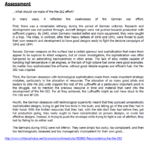- Thread starter
- #501
The Me262 was originally designed to use the BMW003, not the Jumo004.
The 004 never had the thrust to weight ratio like the 003. And both did not have the performance profile that the Hirth engines produced.
I understand that many people out there are fans of the Rolls Royce engines, but if Heinkel was allowed to fully developed the HeS8 engines (008, 011, etc. which had a superior thrust to weight ratio) then the BMW and Junkers engines would have taken a back seat to history...
This is just wishful thinking GrauGeist. The key was always the specific alloy Nimonic. The major engine manufacturers - British, American, French, German and Russian - all exclusively used Nimonic hot end components after the War, at least until the 80s. And it's still used extensively.
The alloy had to not only resist corrosion, high stress, but more importantly creep. At such combinations of high stress and high temperature, most materials will slowly elongate. This is obviously a problem for a turbine blade which has to run with minimal end clearance.
See:
https://www.magellanmetals.com/nimonic-75
"...Nimonic alloys are made up of nickel and chromium. These alloys are characterised by their high-temperature low-creep and high performance. Additives like titanium and aluminium are used for enhancing the strength of the alloy..."
"...Nimonic 75 is an 80/20 nickel-chromium alloy containing titanium and carbon as additives. Nimonic 75 was first introduced for use as turbine blades during the 1940s. Nimonic 75 is readily fabricated and welded. Nimonic 75 alloy exhibits good corrosion resistance, mechanical properties and heat resistance..."
Last edited:

